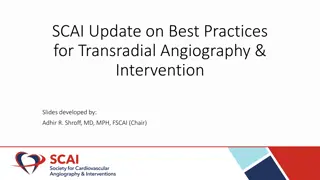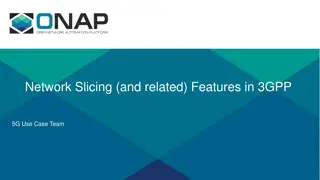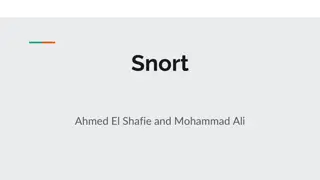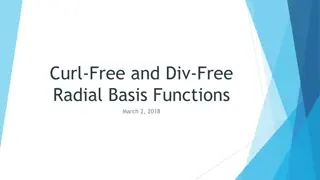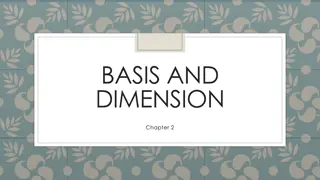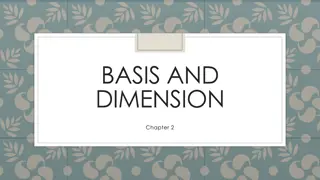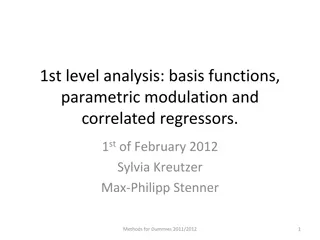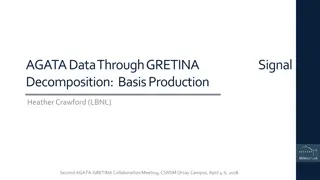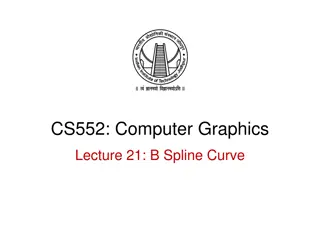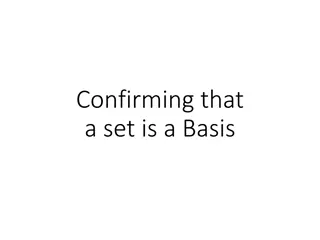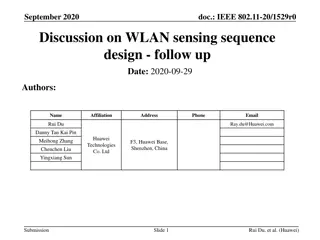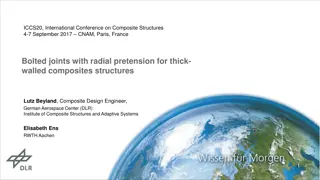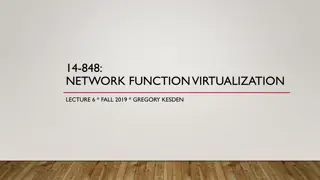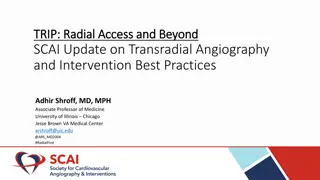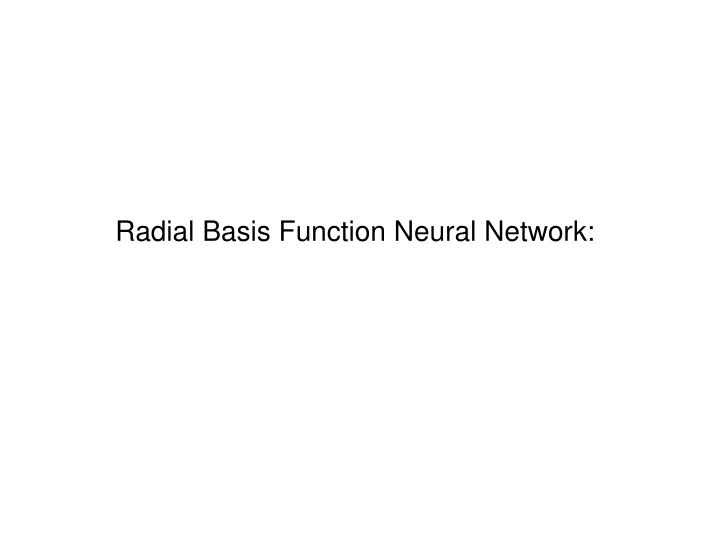
Radial Basis Function Neural Network and Clustering Overview
A detailed overview of Radial Basis Function Neural Network (RBF) and clustering techniques. Explore the use of Gaussians as basis functions, linear least squares with basis functions, and the performance of RBF networks with large datasets. Understand the concept of clustering in unsupervised learning and the application of K-Means Clustering for grouping data based on similarity.
Download Presentation

Please find below an Image/Link to download the presentation.
The content on the website is provided AS IS for your information and personal use only. It may not be sold, licensed, or shared on other websites without obtaining consent from the author. If you encounter any issues during the download, it is possible that the publisher has removed the file from their server.
You are allowed to download the files provided on this website for personal or commercial use, subject to the condition that they are used lawfully. All files are the property of their respective owners.
The content on the website is provided AS IS for your information and personal use only. It may not be sold, licensed, or shared on other websites without obtaining consent from the author.
E N D
Presentation Transcript
Example of Radial Basis Function (RBF) network Single output that is linear combination of basis functions Input vectors d dimensions K nodes in the hidden layer are basis functions with parameters defined by clustering of attribute vectors
Gaussians are the most frequently used basis function j(x) = exp(- (|x- j|/ j)2) Clusters of input data are parameterized by a mean and variance. X is an attribute vector in the training set. Optimum number of clusters is usually not obvious from training data. Validation set can be used to find best number.
Linear least squares with basis functions X = x Given training set { } t,r t N t = 1 Find the mean and variance of K clusters of input data. Construct the NxK matrix D with columns that are each basis function evaluated at all the examples in the training set. Construct a Nx1 column vector r with the response values of the attribute vectors in the training set. 1 1 1 1 1 x x x x ( ) ( ) ( ) ( ) r 1 2 3 K 2 2 2 2 2 x x x x ( ) ( ) ( ) ( ) r 1 2 3 K = = D r x N N N N N x x x ( ) ( ) ( ) ( ) r 1 2 3 K If needed, add a column of ones to include a bias node. Solve normal equations DTDw = DTr for a weight vector w connecting hidden nodes to output node
RBF networks perform best with large datasets With large datasets, expect redundancy (i.e. multiple examples expressing the same general pattern) In RBF network, hidden layer is a feature-space representation of the data where averaging has been used to reduce noise.
Background on clustering Clustering is unsupervised learning to find regularities in data. In clustering, we look for regularities as group membership Assume we know the best number of clusters, K Given K and dataset X, X, we find the size of each cluster P(Gi) and its component density pi(x|Gi), the probability that attribute vector x belongs to cluster i. 6
K-Means Clustering: hard labels Find group labels using the geometric interpretation of a cluster as points in attribute space closer to a center than they are to data points not in the cluster Define trial centers by reference vectors mjj = 1 k t t = x m x m 1 if min j Define group labels based on nearest center i j t = ib 0 otherwise t i b ) = X 1 t t b x Get new trial centers based on group labels = m i t i t ( m k i t i t x m E b Judge convergence by i i = t i 7
t i b t b x Components of mi are just the average of components of attribute vector is cluster i = t m i t i t ( ) = m k i t i t X x m E b i i = 1 t i Dispersion of a cluster is the sum of the distance of each member from the mean of the cluster. E is the sum of the dispersions of the k clusters
Initial centers are arbitrary points in attribute space. Convergence 10
K-means is an example of the Expectation-Maximization (EM) approach to maximum likelihood estimation (MLE) With simple models, like Gaussian distribution, likelihood of parameter values, like mean and variance, can be expressed analytically and calculus can be used to find the best estimates of the parameters. Parameters of the mixture model cannot be solved analytically. EM is a 2-step iterative method to solve the mixture problem. E-step: estimate group labels of xt from current knowledge of mixture components M-step: update mixture component using group labels from E-step 11
K-means clustering pseudo code Assign training examples to clusters Update centroids based on new assignments 12
Davies-Bouldin index (DBI) is used to find the optimum number of clusters. Rationale: Choose K that makes the clusters least similar Rij = similarity of clusters i and j = (Si + Sj)/Mij where Si is the intra-dispersion of cluster i, which is the average separation of its members from the centroid, and Mij is the distance between the centroids of clusters i and j. Small dispersion and wide separation -> low similarity
With K clusters, calculate Rij = similarity of clusters i and j for K(K-1)/2 distinct ordered pairs. For each cluster i, find Ri = max(Rij) DBI is the simple average of Ri over the K clusters Plot DBI(K) over the desired range of K. Chose K with the minimum DBI(K)
https://pyshark.com/davies-bouldin-index-for-k-means-clustering-evaluation-in-python/https://pyshark.com/davies-bouldin-index-for-k-means-clustering-evaluation-in-python/ Davies-Bouldin Index for K-Means Clustering Evaluation in ...
https://pyshark.com/davies-bouldin-index-for-k-means-clustering-evaluation-in-python/https://pyshark.com/davies-bouldin-index-for-k-means-clustering-evaluation-in-python/ Example from link: 2D labeled data. DBI predicts 3 as best number of clusters between 2 and 10 With labeled data, the next question is usually Are class members in the same cluster?
Application of K-means clustering to RBF network j(x) = exp(- (|x- j|/ j)2) Given converged K-means centers, estimate variance for RBFs by 2 = d2max/2K, where dmax is the largest distance between clusters. How do we calculate distance between clusters? dij = ||mi-mj||
RBF network for digit recognition Examples of hand-written digits from zip codes
2-attribute digit model: intensity and symmetry symmetry intensity Intensity: how much black is in the image Symmetry: how similar are mirror images
Assignment 11 Use Weka s RBFnetwork to distinguish hand-written digits 1vs5. Load Weka s RBFnetwork from package manager under Tools on the main menu. Use 1-5-1561-no name.csv for training. Use 1-5-424-no name.csv for testing. After loading the test set, select output predictions under more options. Choose CSV. Run with default settings. Save the results buffer that contains predictions of model on test-set examples. Edit to 2 columns, actual and predicted. Use software like that for HW4 to calculate the accuracy of predictions in each class, the overall accuracy, and the confusion matrix with column sums equal to class size.
Part of csv file from results buffer.
More of csv file from results buffer. 2D linear regression model. R2 = 95.75% Note instance 7 where difference between actual and predicted is large Copy and paste columns actual and predicted into new csv file for analysis of predictions by class and confusion matrix.
2 classes with labels 1 and 5. Choose bin boundary equal to 3 (average of 1 and 5) Saved as scriptHW13.m on class web page.

